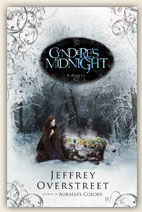
A Tale of Nobility and Savagery
This is the 3rd day of the CSFF tour for Cyndere’s Midnight by Jeffrey Overstreet. See Monday for my overview of it and the first book in the series, Auralia’s Colors, and yesterday for an interview with Jeffrey.
Cyndere’s Midnight is a swirling tale of noble and base elements, of a kingdom trying to find something they lost, and another kingdom in danger of losing what they have, and individual choices to embrace light over darkness.
If you picked up Cyndere without reading Auralia, you would understand the plot for the most part. As with most sequels, it is a deeper experience if you read the whole series. Jeffrey planted seeds for Cyndere in the first one, so there are nice connections to be made.
Jeffrey mentioned in his interview that he is trying to write a beautiful story with language that will stand the test of time. I don’t know if will rise to such a lofty standard, but it is not typical fantasy fare, or Christian fare for that matter. He takes great care in describing the details of the Expanse. His prose continues to be quite poetic, though I felt it wasn’t quite as poetic as Auralia. The subject matter could definitely be part of that, as the character Auralia was the center of the poetry last time. He doesn’t repeat words or phrases repetitively. It is apparent he is using language precisely.
The story is sweeping in its scope, and he keeps the suspense moving along. The confused beastman Jordam becomes the heart of the book as he struggles with the curse on his people. They are driven to drink a substance called Essence for their strength, but could it be corrupting them? Jordam sees hints of something greater in the colors Auralia has created, and a new nobility rises in him as he stumbles into Cyndere’s path.
Other characters are carefully constructed and there are only a couple of very minor characters that seem like throw-away “placeholder” characters. The contrasts in character development is very intriguing.
I really enjoyed Cyndere’s Midnight. In some ways I enjoyed it more than Auralia’s Colors, but other ways I didn’t. Both books are poetic, but I think the language in the first book was a little more lyrical. However, I connected more with Jordam than I did anyone in the first book.
Jeffrey’s writing is dense, and it won’t stand for a quick perusal of a page. You are forced to take it in and chew on it a little. This is mostly very good, but on occasion there are points where a reader can get confused. Also, there were many characters and sub-plots going on, so there were some times when I lost track of what was happening with them.
I mentioned with my review of Auralia’s Colors that I believed it to be a very important book for Christian fiction. Cyndere’s Midnight continues that legacy. In his interview yesterday, Jeffrey said,
Unfortunately, very little that is published in the CBA market stands up to that kind of test. “Christian fiction” is usually notable because of the “message.” It is very rarely written with the kind of artistry that will stand up to critique. I don’t want to write stuff that will only be read by people who believe what I believe. I want it to be read by people who love imaginative storytelling… and I want them to still be reading it a hundred years from now.
His answers inspired me to take a second look on what I’m writing and how I do it. I think he is taking a bold step, writing a different kind of book that can’t be categorized within the bounds of CBA fiction. I applaud him for setting a lofty goal for himself in his own creativity. I don’t think he fully realizes the potential, as I think the plot can be clarified a little more, but it is clearly an artistic work that is unique among other fantasy books.
—